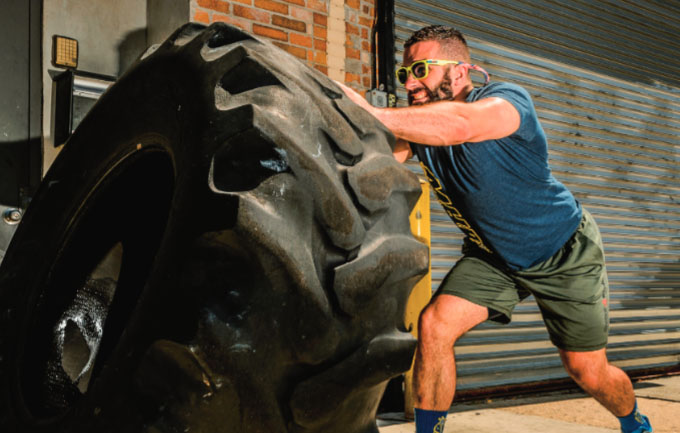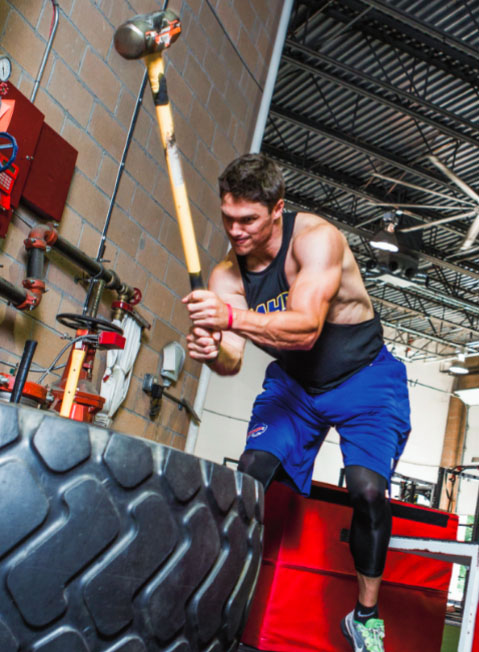


You only need to visit any modern gym to know that strongman training is making its way into mainstream fitness programs. The types of training and events that not long ago were seen on the televised World’s Strongest Man competition are now being used to enhance performance and conditioning in everyone from elite MMA fighters to suburban moms doing outdoor boot camps.
The strength gains and the cardiovascular benefits associated with strongman training have been widely noted. As a result, many gyms now include a host of implements such as battle ropes, pushing/pulling sleds, and even Atlas stones. One of my favorites is the tractor tire. The most common use for tires is flipping them for predetermined amounts of repetitions or time.
Outside of athletic training, tire flips are actually a no-brainer for everyday fitness enthusiasts and people with physique goals. Building muscle and shedding fat are usually the name of the game, and tire flips are guaranteed to produce both. Since the tire flip requires your total-body involvement to perform the movement, the demands it places on a body are great for conditioning.
It’s important to stress that like many other exercises, tire flips are not meant for everyone. Before you even attempt to flip a tire, you should have a firm base of strength developed in a more conventional setting. Knowing how to perform a barbell squat and a deadlift correctly is crucial, but per-forming each lift with an adequate load is important for developing the strength needed for flip-ping tires correctly. Tire flips require sound under-standing of placing your body in the right position, especially when it comes to your spine.
There are different styles of flips that should be used for different training protocols. If you’re looking to add this unique movement to the mix of your current training but still keep things safe and fun, then opt for a lighter tire. A lighter tire will be more forgiving if your technique falters. It will also allow you to increase the volume of flips you perform if doing a workout for either time or distance. The nature of your exercise and fitness level will determine the weight of your tire. For someone just looking to have fun and get a great total-body workout, I recommend choosing a tire between 150 and 300 pounds. Believe it or not, females can usually handle the lighter one, while males should be able to handle the heavier one.
Trainees with a solid strength base and experience in the weight room should use a bigger tire weighing between 300 and 500 pounds. In my gym, the heaviest tire we have is 650 pounds, but there are tires that can weigh over a 1,000 pounds. The heavier the tire gets, the more conducive it is for strength development and specific for anyone training for strongman competitions. If you are someone who has no interest in competitions, I wouldn’t attempt flip-ping anything over 700 pounds.
There is a critical form involved in lifting a tire correctly. A common technique involves placing your feet close to the tire, squatting down, and then using your legs and arms to flip the tire. This is usually done only with lighter tires. Some people are actually strong enough to squat down and basically curl the weight up, but this should definitely be avoided. In this position, you are more susceptible to starting off with a rounded spine, which is usually never a good position.
The technique I recommend is more commonly seen in experienced lifters. Stand about a foot back from the tire and then crouch down and take a firm grip with both hands under the edge. Lean your chest into the tire and keep your back flat and engaged. Explosively drive into the rubber and also up at an angle, extending through the ankles, knees, and hips. When the tire gets to about 45 degrees, jam one knee into it. This should also allow you to shift your hands into a pushing position to get the tire over. This process can be done quickly or take a few seconds to complete, depending on fatigue and the weight of the tire. I’ve seen people spend close to 20 seconds attempting to flip a tire.
Dedicate no more than two days a week to flipping tires unless you’re preparing for a strongman competition. Two days a week allows you to mix up speed on one day and strength on another day. You can attempt to flip a lighter tire for time one day and then a heavier one for reps on another. After you’ve practice flipping the tire, try one of my favorite high-intensity workouts:

Three to Four Sets of 60-Second Flips: If you’re out-side and have more space, you can flip the tire continuously down a path. If you’re inside, flip the tire over and run to the other side to flip it back. Continue doing this for 60 seconds and then take a 60-second rest before repeating again. I suggest counting the number of flips it takes you to do the first round when you’re fresh. Try to maintain the same number of flips you did the first set for all the sets.
Three to Four Sets of Two to Four Flips: This one should be done with a heavier tire. Focus on good technique and being explosive during each rep. I actually recommend doing this toward the beginning of your training session when you’re well rested so you can focus on maximum intensity throughout each flip.
Three to Four Sets of 20-Yard Timed Flips: This is a great workout if you have a partner and two tires of equal weight. Both of you should simply start flipping the tire for 20 yards and see who can finish first. You can do this by yourself and track your time. Every time you train, try to better your time from the last one.
Tire Circuit: One of the most exciting things to do with tires is combine them with other exercises or create a strongman complex. One circuit that we do at my gym is 90 seconds of all-out intensity, and it only demands two pieces of cheap equipment: a truck tire and sledge-hammer.
Tire Flips: 30 seconds
Sledgehammers: 15 seconds striking each side of the tire
Tire Jumps: 30 seconds
Tires are a great piece of exercise equipment to add to your training arsenal. Tire flips target your entire body, including your posterior chain (lats, lower back, glutes, hamstrings, and calves), as well as your anterior chain (chest, abs, and quads). Your biceps, triceps, shoulders, forearms, and handgrip all get worked Lifting odd objects that weren’t designed for a gym challenges your body and stimulates massive strength and muscle-mass gains. Remember to train hard, but train smart.
Cornell Hunt is a Certified Strength and Conditioning Specialist who trains athletes in Fairfield, New Jersey, and is the Xtreme Trainer for MHP. For more info, visit MHPstrong.com





















You must be logged in to post a comment Login